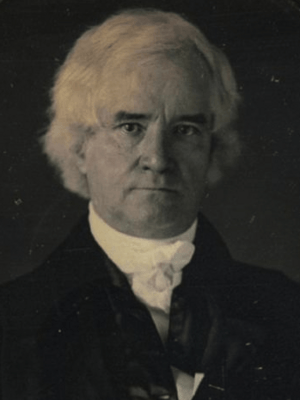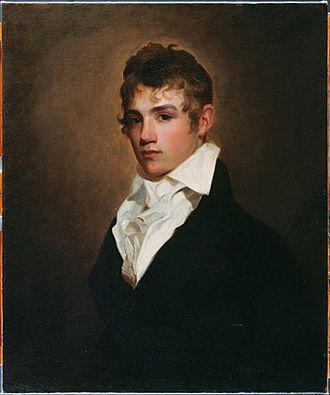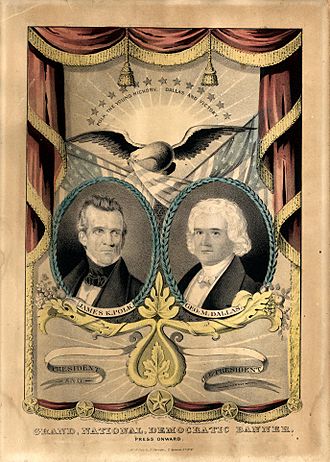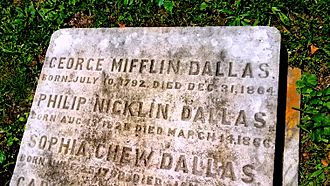George M. Dallas facts for kids
Quick facts for kids
George M. Dallas
|
|
|---|---|

Dallas in 1848
|
|
| 11th Vice President of the United States | |
| In office March 4, 1845 – March 4, 1849 |
|
| President | James K. Polk |
| Preceded by | John Tyler |
| Succeeded by | Millard Fillmore |
| United States Minister to the United Kingdom | |
| In office April 4, 1856 – May 16, 1861 |
|
| President | Franklin Pierce James Buchanan Abraham Lincoln |
| Preceded by | James Buchanan |
| Succeeded by | Charles Francis Adams Sr. |
| United States Minister to Russia | |
| In office August 6, 1837 – July 29, 1839 |
|
| President | Martin Van Buren |
| Preceded by | John Randolph Clay |
| Succeeded by | Churchill C. Cambreleng |
| 17th Attorney General of Pennsylvania | |
| In office October 14, 1833 – December 1, 1835 |
|
| Governor | George Wolf |
| Preceded by | Ellis Lewis |
| Succeeded by | James Todd |
| United States Senator from Pennsylvania |
|
| In office December 13, 1831 – March 3, 1833 |
|
| Preceded by | Isaac D. Barnard |
| Succeeded by | Samuel McKean |
| United States Attorney for the Eastern District of Pennsylvania | |
| In office April 15, 1829 – December 13, 1831 |
|
| President | Andrew Jackson |
| Preceded by | Charles Jared Ingersoll |
| Succeeded by | Henry D. Gilpin |
| 58th Mayor of Philadelphia | |
| In office October 21, 1828 – April 15, 1829 |
|
| Preceded by | Joseph Watson |
| Succeeded by | Benjamin Wood Richards |
| Personal details | |
| Born |
George Mifflin Dallas
July 10, 1792 Philadelphia, Pennsylvania |
| Died | December 31, 1864 (aged 72) Philadelphia, Pennsylvania |
| Resting place | St. Peter's Episcopal Church in Philadelphia |
| Political party | Democratic |
| Spouse |
Sophia Nicklin
(m. 1816) |
| Children |
|
| Parents |
|
| Relatives | Alexander J. Dallas (brother) |
| Education | Princeton University (BA) |
| Signature | |
George Mifflin Dallas (born July 10, 1792 – died December 31, 1864) was an important American politician and diplomat. He served as the mayor of Philadelphia from 1828 to 1829. Later, he became the 11th Vice President of the United States from 1845 to 1849. He also worked as the U.S. Ambassador to the United Kingdom from 1856 to 1861.
George M. Dallas was the son of U.S. Treasury Secretary Alexander J. Dallas. George went to good schools and then became a lawyer. He worked for the Treasury Department and the Second Bank of the United States. He became a leader in the Democratic Party in Pennsylvania.
From 1828 to 1835, he was the mayor of Philadelphia. He also served as a U.S. attorney and Pennsylvania's attorney general. He was a U.S. Senator for Pennsylvania from 1831 to 1833. President Martin Van Buren later made Dallas the U.S. Ambassador to Russia from 1837 to 1839.
In 1844, Dallas was chosen as James K. Polk's running mate for president. They won the election. As Vice President, Dallas supported expanding the country. After his time as Vice President, he became the U.S. Ambassador to the United Kingdom. He retired from public service in 1861.
Contents
Early Life and Education
George Mifflin Dallas was born in Philadelphia on July 10, 1792. His parents were Alexander James Dallas and Arabella Maria Smith Dallas. His father, Alexander, was born in Jamaica. He served as the Secretary of the Treasury under President James Madison. He was also briefly the Secretary of War.
George was the second of six children. His brother, Alexander, later became a naval commander. The Dallas family lived in a large house in Philadelphia. They also had a country home by the Schuylkill River.
George went to private schools run by Quakers. He then studied at the College of New Jersey, which is now Princeton University. He graduated with high honors in 1810. While in college, he joined several student groups. After college, he studied law in his father's office. He became a lawyer in 1813.
Starting His Career

After finishing law school, Dallas wanted to join the War of 1812. However, his father did not agree. Soon after, Dallas became the private secretary to Albert Gallatin. He traveled to Russia with Gallatin, who was trying to arrange peace talks between Great Britain and the United States.
Dallas enjoyed his time in Russia. After six months, he was sent to London. His task was to see if the War of 1812 could be ended through talks. In August 1814, he arrived in Washington, D.C.. He delivered an early draft of Britain's peace terms.
President James Madison then appointed him as the remitter of the treasury. This job involved handling money for the government. Since the work was not too heavy, Dallas learned more about politics. This was his main interest. He later became a lawyer for the Second Bank of the United States. In 1817, his father died. Dallas then left the bank and became the deputy attorney general of Philadelphia. He held this job until 1820.
Political Journey
After the War of 1812, politics in Pennsylvania were very active. The Democratic Party had two main groups. One group, the "Family party," was led by Dallas. They believed in a strong national government. This government would support tariffs (taxes on imported goods) and a central banking system. It would also improve the country's transportation to help trade.
The other group was called the "Amalgamators." This group was led by James Buchanan, who would later become president.
Dallas was elected mayor of Philadelphia by the Family party. But he quickly found the job boring. In 1829, he became the United States attorney for eastern Pennsylvania. His father had held this same position earlier. Dallas stayed in this role until 1831.
In December 1831, he was elected as a Senator for Pennsylvania. He served for less than 15 months, from December 13, 1831, to March 3, 1833. He led the Committee on Naval Affairs. Dallas decided not to run for re-election. This was partly because of a disagreement about the Second Bank of the United States. Also, his wife preferred to stay in Philadelphia rather than move to Washington.
Dallas went back to being a lawyer. He was Pennsylvania's attorney general from 1833 to 1835. He also became a leader in the Freemasons in Pennsylvania in 1835. President Martin Van Buren appointed him as the U.S. Ambassador to Russia. He served from 1837 to 1839. Dallas was offered the job of Attorney General, but he turned it down. He returned to his law practice.
Before the 1844 United States presidential election, Dallas worked to help Van Buren win the Democratic nomination. However, James K. Polk ended up winning the nomination.
Serving as Vice President (1845–1849)
At the Democratic National Convention in May 1844, James K. Polk was nominated for president. Silas Wright was first chosen as his running mate. But Wright declined the offer. The delegates then chose Dallas as his replacement. Dallas was not at the convention. Delegates traveled to Philadelphia to tell him the news. Dallas accepted the nomination, though he was a bit unsure.
Polk and Dallas won the election. They won the popular vote by a small amount. They also won with 170 out of 275 electoral votes.
Important Decisions as Vice President
Dallas decided to use his position as Vice President to help with two main goals. These were lowering tariffs and expanding the country's land. As a Pennsylvanian, Dallas had usually supported tariffs. Tariffs are taxes on imported goods that protect local industries like coal and iron. But as Vice President, he agreed to support lowering them.
The Vice President has the power to break tied votes in the Senate. Dallas believed this power was as important as the President's power to veto laws. He said he cast 30 tie-breaking votes during his four years in office.
Dallas tried to avoid casting a tie-breaking vote on the tariff issue. He talked to senators during the debate over the tariff bill in 1846. He told his wife that senators were trying to influence his vote.
However, the Senate vote on the Walker Tariff ended in a 27-to-27 tie. On July 28, 1846, Dallas cast the tie-breaking vote in favor of the tariff. He explained that he had to represent all states, not just Pennsylvania. This decision helped President Polk and some party leaders. But it greatly hurt Dallas's support in his home state of Pennsylvania. This ended his chances for future elected office. He even told his wife to be ready to leave Philadelphia if there were riots because of the tariff bill.
While the tariff vote hurt Dallas in Pennsylvania, his strong views on Oregon and the Mexican War also affected his political future. He strongly supported gaining control of Texas, the Southwest, Cuba, and parts of the Oregon territory. This idea was called "Manifest Destiny."
As the leader of the Senate, Dallas helped President Polk's plans. He cast many tie-breaking votes. Dallas wanted the United States to take all of the Oregon Territory and all of Mexico during the Mexican–American War. However, he accepted compromises that led to the U.S. gaining parts of both areas.
Dallas hoped to run for president in the 1848 United States presidential election. President Polk had promised to serve only one term. But Dallas's vote to lower the tariff hurt his support in Pennsylvania. Also, his ideas about how new territories should be governed caused more opposition against him.
After the Vice Presidency (1849–1864)
In 1856, President Franklin Pierce appointed Dallas as the U.S. Ambassador to Great Britain. He served in this role from February 4, 1856, until May 16, 1861. When he started, he had to deal with important issues. These included questions about Central America and a request for the British minister to the U.S. to be removed. Dallas handled these matters carefully and peacefully.
After his time as ambassador, Dallas retired from public life. He did not take part in politics again, except to speak against states leaving the Union.
His Death
Dallas returned to Philadelphia. He lived there until he died from a heart attack on December 31, 1864. He was 72 years old. He is buried at St. Peter's Episcopal churchyard in Philadelphia.
Legacy and Namesakes
Several places in the United States are named after George M. Dallas:
- Dallas County, Iowa, and the city of Dallas Center, Iowa.
- Dallas County, Arkansas.
- Dallas County, Missouri.
- Dallas County, Texas.
Other cities and towns named in his honor include:
- Dallas, Georgia (the main town of Paulding County, Georgia).
- Dallas, North Carolina (the former main town of Gaston County, North Carolina).
- Dallas, Oregon (the main town of Polk County, Oregon).
- Dallastown, Pennsylvania.
It is still discussed whether the large city of Dallas, Texas, was named after him. You can find more information in the History of Dallas, Texas (1839–1855).
Images for kids
See also
 In Spanish: George Mifflin Dallas para niños
In Spanish: George Mifflin Dallas para niños



